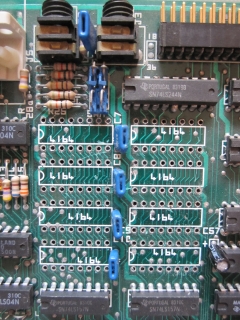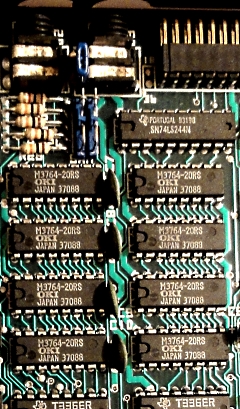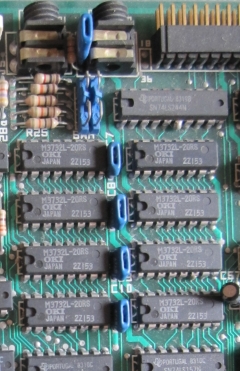|
 |
The Memotech MTX Series |
 |
MTX Series DRAM

Memotech MTX500 / 512 computers usually have 32 kbytes and 64
kbytes respectively of
DRAM on the 4000-0x computer board, although some MTX512s
have the 64 kbytes of memory split between the computer board
and an expansion memory card.
The DRAMs are 32k/64k x 1 bit,
each byte of memory requiring 8 chips to give 32kbytes/64kbytes
of RAM.
|
A close up
of the RAM locations on an MTX computer motherboard
- the RAM chips are located at positions 2C to 5C
and 2D to 5D, in front of the cassette In/Out ports.
On the
MTX500 and MTX512, the RAM is soldered directly onto
the computer board, with the RAM removed, you can
see the numbers "4164" stencilled at each chip
location. (The "4164" is a generic designation for a
64k x 1 DRAM such as the TMS4164.)
The RS128
had 128 kbytes of RAM, 64k on a MTX512 computer
board and the additional 64k on an expansion memory
board.
On the
MTX512S2, the 32k/64k RAM chips were replaced by DIL
sockets and jumper wires added to support the extra
address line required for the 256k x 1 DRAM chips to
provide 256kbytes of RAM. |
 |
|
Although
the RAM locations on the board are marked "4164",
the MTX 500/512
Service Manual records that the RAM chips fitted
were OKI Semiconductor MSM3764-20 64k DRAMs (for the
MTX512) as shown.
At the height of the home computer boom, DRAM was
relatively expensive and the yield of fully working
ICs was poor, to keep the price down, the
manufacturers were able to sell half working chips
as functional, but lower capacity, RAMs.
- For example, the M3764 has an upper and lower
section of 32k, chips that had failed factory
testing on only one half of the chip could be used
as 32k RAMs provided that the OEMs addressed the RAM
appropriately.
The half that was working is denoted by the suffix
on the chip :-
As light of this, the "32k" RAMs fitted to
MTX500s had been manufactured as 64k but sold as half
working "H" or "L" 32k RAMs. |
 |
|
All RAMs
must be of the same type, H or L,
and a corresponding link (6) set on the computer
board (see the Service Manual for details).
The photo
shows the RAM fitted to a "32k" MTX500 computer
board, in this case, the board is using "L" type RAM
and is configured to use the lower half of the 64k
chip by setting Link 6 (not shown) to "L".
All of the MTX500/512s that I have seen use OKI RAM,
but TI made equivalents for all of the RAMs :-
(The use
of "half working" RAM was also used to provide the upper 32kbtes of
RAM in the 48k ZX Spectrum using either OKI or TI
RAM.)
Since the 32k and 64k chips are identical, it
follows that a failed 32k chip can be replaced with
a working 64k chip (from the same manufacturer). |
 |
Should your MTX develop a RAM fault, you obviously need
to obtain 4164, or equivalent, RAM chips - these are
obsolete and not too easy to come by. There are still some
available, from what I have seen, mainly from ebay.com in
the US.
The chip manufacturers used a suffix on the chip ID to denote
the access speed, e.g., "-15" for 150ns or "-20" for 200ns. The
Service manual records that the original OKI RAM was -20, i.e.,
had an access time of 200ns.
I have collated data from a number of manufacturers below -
if you know of any more, please let me know. Full
specification data for these components can be found on my
Datasheets
page.
| Manufacturer |
Designation |
Code |
Access |
Suitable |
| Motorola |
MCM4164CP |
-15 |
150ms |
Y |
| Motorola |
MCM4164CP |
-20 |
200ms |
Y |
| OKI |
(MS)M3764 |
-20 |
200ms |
Y |
| |
|
|
|
|
| |
|
|
|
|
| TI |
TMS4164 |
-20 |
200ms |
N |
| |
|
|
|
|
| |
|
|
|
|
| |
|
|
|
|
| |
|
|
|
|
RAM manufactured by other than OKI may have subtle internal
timing differences, but it is assumed that RAM with similar
quoted access times will be suitable.
There is a useful page about 4164 class DRAMs on the
minuszerodegrees website.
When I was looking to source replacement RAM for my MTX
computers, I came across this very useful TI document from 1986,
downloaded from the Western
Horizon Technologies TI 99/4a and Geneve Archive. You can
browse the archive in your
web browser. (Note: Some of these PDFs are quite large,
Chapter 5 is the biggest at 46 MB.)
|